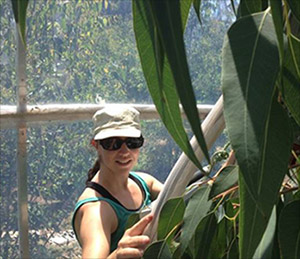Way Down Under: Western researcher studies forest-responses to climate change

Biology Assistant Professor Dr. Danielle Way skipped over winter and across the globe this year, from the snow-covered Western University to the sunny University of Western Sydney (UWS), Australia. Way was awarded a fellowship from the Hawkesbury Institute for the Environment at UWS and spent the last two months studying the impacts of climate change on tree carbon dynamics.
Way was attracted to the Hawkesbury Forest Experiment because of the capacity to grow entire 12- metre tall eucalyptus trees in controlled-environment growth chambers to study their response to warming temperatures. She hopes to use her findings from the growth chambers to scale-up from individual leaves and trees, to whole forests. Overall, this research will help us to understand how trees acclimate to conditions associated with climate change and what the consequences of acclimation will be for whole-forest and woodland ecosystems. Way will focus on both photosynthesis and respiration in the trees with the goal of uncovering some potentially unforeseen effects of climate change.
Photosynthesis and the consumption of CO2 is a familiar feature of plants; however, even when they are photosynthesising, plants are also respiring and emitting CO2. These respiration processes allow for the growth and maintenance of cells - much like the respiration processes that also keep our bodies functioning. Both photosynthesis and respiration contribute to the flux of carbon from leaves, although photosynthesis is much larger than respiration during the day; however, daytime respiration is often ignored by researchers that focus on photosynthesis.
Way believes that it is this contribution to plant carbon fluxes that makes respiration an equally important component of climate change research. She explains that if the rate of respiration is higher in a warmer climate, its seemingly small contribution may be magnified. In a discipline where people study global climate by multiplying the processes from a few leaves or one tree into thousands of square kilometers of forest, small changes can lead to big errors in the resulting predictions. Way’s attention to this detail in her research will ensure that, in this case, we don’t miss the trees for the forest when it comes to understanding the ecosystem-level impacts of climate change.
If you’d like to learn more about the Hawkesbury Forest Experiment, you can access their website here: http://www.uws.edu.au/hie/research/research_projects/hawkesbury_forest_experiment
Or Dr. Way’s research page here: http://publish.uwo.ca/~dway4/

